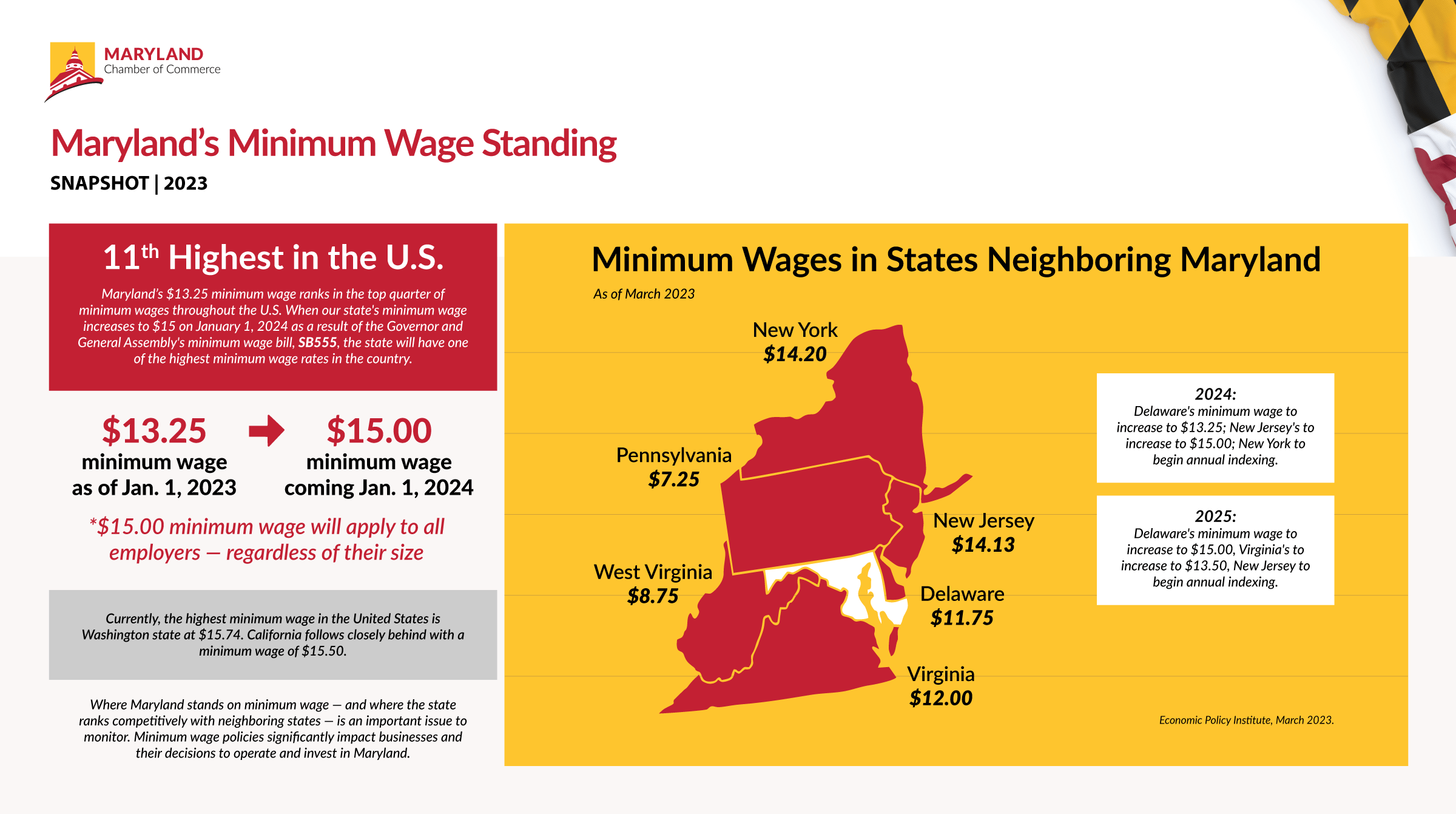Blog
Understanding Maryland’s Economic Competitiveness: Spotlight on Minimum Wage
May 17, 2023
The information provided below is based on data from our 2023 Competitiveness Redbook. Please check back soon for an updated analysis of our 2024 data.
As we continue sharing spotlights on data from our 2023 Competitiveness Redbook for Maryland revealing where Maryland ranks compared to other states in key economic indicators, today we’re focusing in on where we rank for minimum wage.
What the data shows:
As of March 1 2023, Maryland had the 11th highest minimum wage rate in the country, with a minimum wage of $13.25 (Economic Policy Institute, March 2023).
When our state’s minimum wage increases to $15 on January 1, 2024 as a result of the Governor and General Assembly’s minimum wage bill, SB555, the state will have one of the highest minimum wage labor rates in the country.
Economic Indicator Spotlight: Where Maryland Ranks for Minimum Wage Rates
Here’s a closer look at what the data reveals and why it matters to Maryland:
- When compared to neighboring states, Maryland’s minimum wage is higher than Pennsylvania’s ($7.25) and West Virginia’s ($8.75). Maryland’s minimum wage is also higher than Delaware and Virginia’s minimum wages of $11.75 and $12.00, respectively, while New Jersey and New York have slightly higher minimum wages than Maryland, with wages of $14.13 and $14.20, respectively.
- The states with the highest minimum wage rates in the country are Washington state ($15.74), California ($15.50) and Massachusetts ($15); Maryland’s 2024 minimum wage increase will place the state in the top tier for highest minimum wage rates paid in the country.
Why it matters: Where Maryland stands on minimum wage — and where the state ranks competitively with neighboring states in particular — is an important issue to monitor. Minimum wage policies can significantly impact businesses and their decisions to operate or invest in Maryland. It’s important to note that businesses may also respond to minimum wage increases in other ways, such as driving them to increase prices or reduce employee hours or benefits.
While businesses value investing in human resources and ensuring that employees receive fair and livable wages, the impacts of higher wages can lead to increased costs and potential job losses. As we move forward, we urge policymakers to keep these potential impacts in mind, working to create and implement policies in a way that supports workers without harming businesses or the economy.
- Minimum Wage Tracker (The Economic Policy Institute)
- Topics: Employment Law, Minimum Wage (U.S. Chamber of Commerce)
- What Are the Pros and Cons of Raising the Minimum Wage (2022, Investopedia)
- NFIB Warns Maryland Legislators Against Accelerated Minimum Wage Hike, 2023 (The National Federation of Independent Business)
- State Minimum Wage Rate for Maryland: 1968-2023 (St. Louis Fed Economic Data Series)
- Characteristics of Minimum Wage Workers, 2021 (U.S. Bureau of Labor Statistics)
- How raising minimum wage to $15 per hour could affect workers and small business (CNBC, 2021)




A Turning Point for Maryland, and We’re Just Getting Started